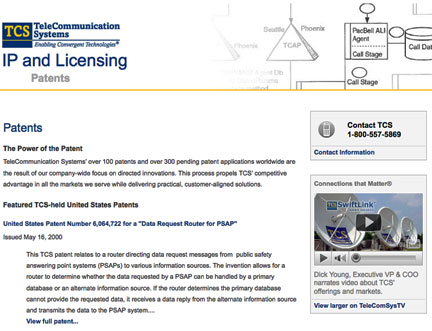TeleCommunication Systems, Inc. (TCS) (NASDAQ: TSYS), a developer and provider of highly reliable and secure mobile communication technology, has announced that the U.S. Patent and Trademark Office has issued four patents to TCS related to mobile location technology:
- "Method and System for Saving and Retrieving Spatial Related Information" (U.S. Patent No. 7,903,001)
- "Method and Apparatus for Sending, Retrieving and Planning Location Relevant Information" (U.S. Patent No. 7,913,179)
- "Wireless Network Location-Based Reference Information" (U.S. Patent No. 7,904,100)
- "Location Sensitive Messaging" (U.S. Patent No. 7,899,468)
"Method and Apparatus for Sending, Retrieving and Planning Location Relevant Information" — Location-based applications are increasingly relying on social communities of users of location-enabled devices to disseminate information to other users or groups. Aspects of the invention provide a means for sending and receiving relevant location-based information using a graphical interface. In light of the explosive growth of touch-based mobile devices and tablets, this patent enables a graphical solution for sending relevant information between wireless users based on their location or their position within a spatial map. The information can be sent between two users, within a group of users, or between mobile phones, automobiles, or other connected devices and machines. Examples of the types of information that can be sent include navigation directions, address information, messages, and points of interest. The patent also discloses methods that allow privacy controls to be set before any information is sent or received.
"Wireless Network Location-Based Reference Information" — Many wireless service consumers are familiar with 4-1-1 directory assistance services, which allow consumers to call or text message 4-1-1 to retrieve information. One shortcoming of current directory assistance is that a users' location is not automatically provided, requiring users to manually input their location information or inform the operator of their whereabouts. Aspects of the invention disclose a method and system whereby a wireless user sends a text message to 4-1-1 and the user's location is automatically provided to the service. Another advantage of the invention is that, after dialing 4-1-1, the user may enter additional digits that correspond to the type of information requested, such as nearby gas stations, restaurants, or ATM machines.
"Location Sensitive Messaging" — Text messaging among friends in social networks is one of the most popular forms of wireless communication. The advent of a location determination function on wireless phones enhances the functionality of messaging among community members when they wish to congregate at a given location. One aspect of the invention describes a method whereby a text message sent by a user is received by friends on a buddy list or in a social network based on the friends' proximity to the sender. Thus, a wireless user who checks in at a local restaurant can send a message that alerts nearby friends that he or she has arrived. Customized directions to the user's location may also be sent to his or her friends using each individual friend's current location as the starting point.


